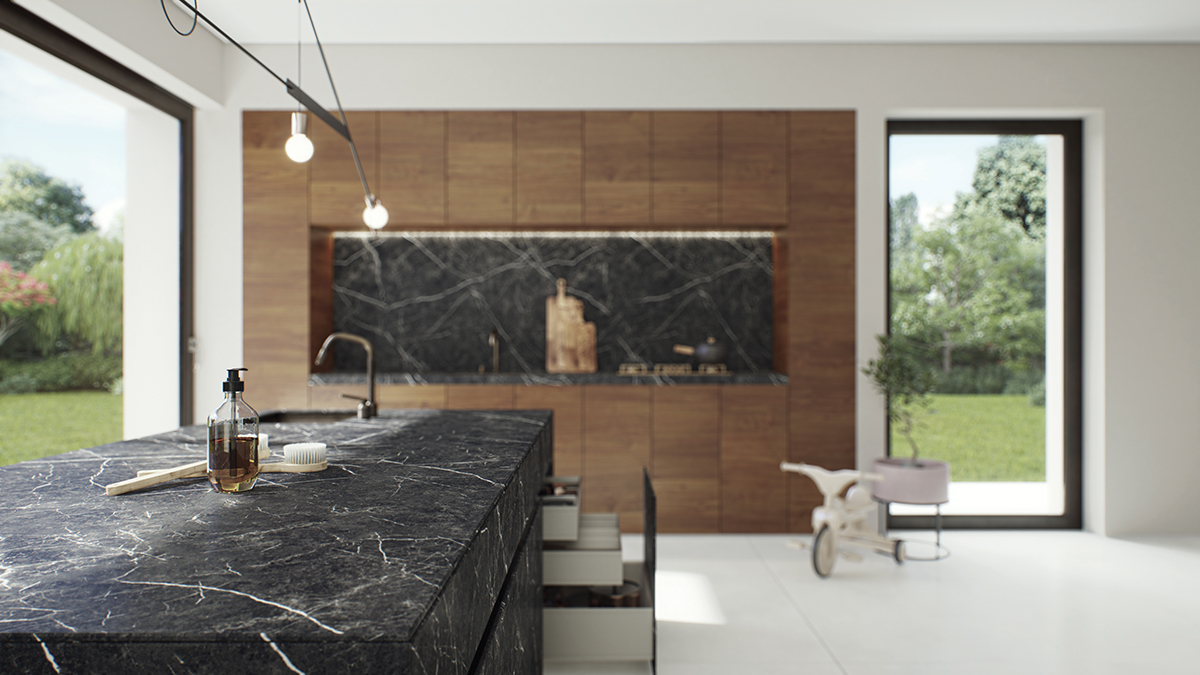Leading quartz company Caesarstone has released its first porcelain collection in the UK.
While quartz remains the most popular and still growing hard surface for kitchens, porcelains have been growing rapidly, so it did not come as a surprise when Caesarstone previewed a porcelain range at the KBB exhibition in the NEC, Birmingham, at the beginning of March. Now it is launching more than 20 porcelain surfaces this month (July).
The porcelain range will use the same Caesarstone name as the quartz, with the aim of strengthening the brand’s reputation as a leading provider of premium worktops.
Caesarstone Porcelain arrives after what the company describes as an intensive two-year design and R&D programme, in which the brand focused more than three decades of stone surfaces experience in the creation of an inaugural suite of porcelain surfaces.
Caesarstone says the porcelain range offers rich colours, bold designs, large patterns and “wonderful tangible textures”.
The porcelains have been aligned with existing Caesarstone collections: the Metropolitan Collection, with designs that celebrate an industrial aesthetic; The Supernatural Collection, inspired by nature; and The Classico Collection of shades that provide a foundation for interiors.
Mor Krisher, Caesarstone’s Chief Designer, explains what he and his team wanted to achieve with the porcelains. “We took stone back to its roots – to a raw, warm, earthy place – employing a range of colours, from delicate tones and pastels to warm shades in bold and dramatic patterns. Our goal was to emphasise stone’s materiality rather than attempt to flatten it, to pull out the texture. The feeling should be natural above all.”
Porcelain surfaces are sometimes described as ceramic, sintered, compact or ultra-compact materials. They blend ceramic clays, other natural materials and mineral colourings by compressing them (sintering) and then firing them. The design is printed on the surface before the slab is fired – and developments in printing technology over the years have helped increase porcelain’s popularity.
Quartz surfaces, sometimes described as engineered stone, are a blend of quartz minerals and other materials and colour pigments in resin polymers. These are then moulded, compressed, and heated to form the slab.
The final look and technical performance of either porcelain or quartz surfaces is reliant on the quality of the raw materials, as well as the expertise and capabilities employed in crafting them. Caesarstone considers both make ideal kitchen worktop surfaces when, like its products, they are manufactured to the highest standards using best quality ingredients. It offers a (not entirely unconditional) lifetime warranty on its products.
Caesarstone’s Porcelain collection includes:
- 501 Snowdrift – white with delicate golden-brown veins on a misty base.
- 503 Circa – a white base with bold, light grey veins outlined in heavier dark greys, reflecting Statuario marble.
- 504 Lumena – a white pearl base with veins in several greys that crisscross the slab. Translucent variations in the surface provide depth and dimension.
- 413 White Ciment – a whitewashed surface covered with a hazy imprint of a subtle mesh. It has an Ultra Rough finish creating an interplay with the soft colour.
- 511 Smokestone – with white lines across a ‘midnight’ body, again with a tactile Ultra Rough finish.
- 302 Metallio Black – inspired by the transformation of ores such as lead and iron.

